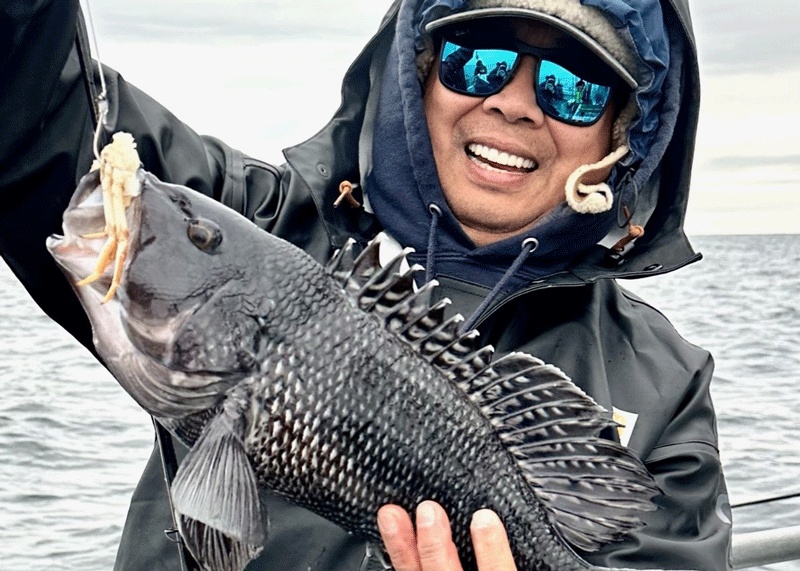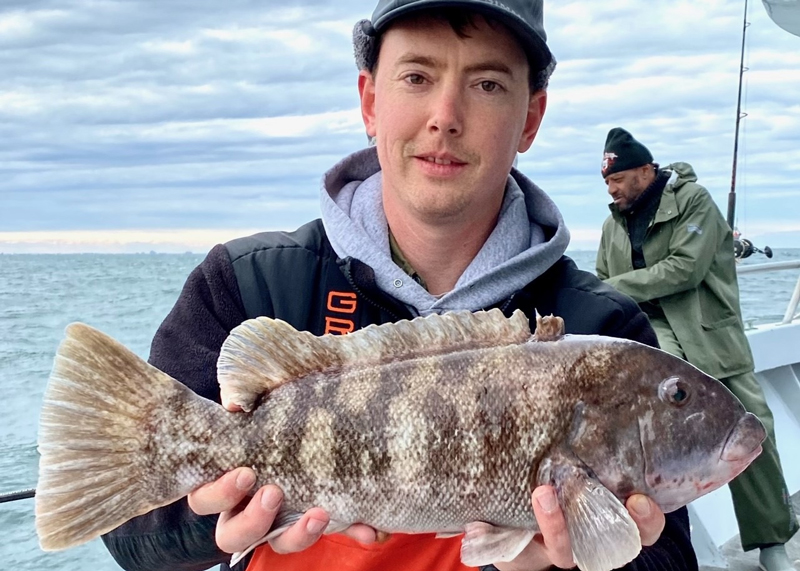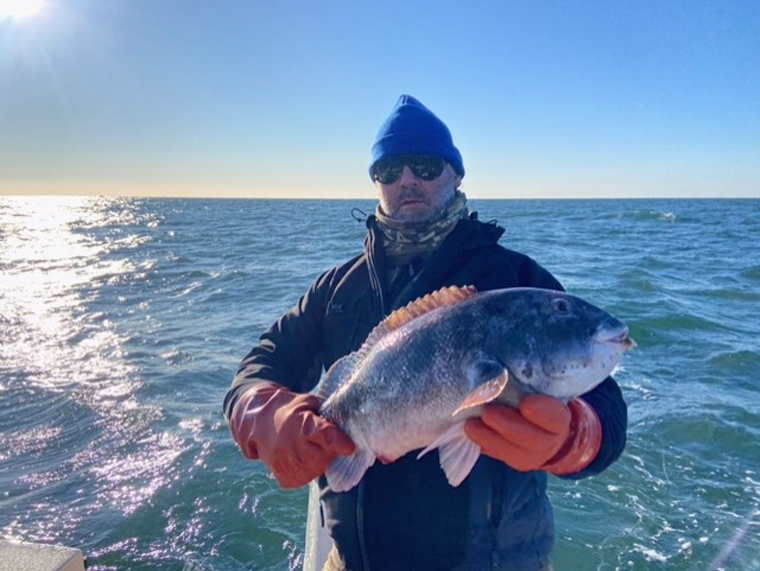Coastal Mid-Atlantic Fishing Report, January 27 Update:
We have good news from the Virginia Marine Resources Commission. They have voted to open a special recreational black sea bass season from February 1 through the 28 of 2023. More information regarding the special season can be found on the VMRC website. A free permit is required to participate, which can be found here. After not opening the special season last year, this is a great opportunity for winter fishing while other bites are limited.

The mid-winter fishing lulls are really starting to set in as we eagerly await new angling opportunities. However, dedicated anglers can still find some fish despite the cold. Recent weather hasn’t been providing many great fishing days, so it’s been important to take advantage of the good ones when we get them. Captain Monty has pulled the Morning Star through the Ocean City inlet ISO tautog in recent days and reports a finicky tog bite but some nice fish (including some over the 10-pound mark) coming over the rails. He’s been switching spots regularly to find biting fish and mentioned catching a few large sea bass (released, of course) plus a keeper flounder.
Big ocean rockfish can still be found off the coast, but they must be targeted within three miles of shore. We haven’t received any direct reports from anglers targeting these fish recently so it’s hard to say where exactly the schools have been. The most recent intel was that there were some decent schools to the south of Ocean City feeding on schools of bunker. As always, they key is, find the bait and you will find the fish. Areas around Virginia Beach have also been a historically popular location for targeting these trophy rockfish as they stage for the spring spawning migration. It’s important to note that in the winter, the time of opportunity for getting these fish to bite is a lot shorter. They aren’t always eating but when they do eat and you happen to be where they are eating, it’s game on. Metal jigs and soft plastics like BKD’s on heavier jigheads is the typical presentation that can get them biting.
Coastal Mid-Atlantic Fishing Report, January 19 Update:
Fishing reports from our coast were slim this week to say the least. A mix of wind and poor weather has made fishing difficult recently and it looks like more wind and cold weather is on the way in the extended forecast. Although we didn’t receive any reports this week, there had been schools of large rockfish scattered around within the three-mile zone. These fish have been spread out over a fairly large area off of the Maryland and Virginia Beaches. When they are located, they are usually rolling on bunker.

Our one regional winter mainstay of tautog fishing has been decent. Tautog in the five-to-seven-pound range are being caught on crab baits at the nearshore wrecks and reefs along the coast. Boats targeting them are having mixed success from Ocean City down to Virginia Beach.
Now is a great time to remind anglers how important boating safety is during winter. Wearing a life jacket and keeping a close eye on the weather are extremely important in the colder months. It is also a good idea to fish with a buddy and make sure others know your plan for the day prior to leaving the dock. Water temperatures in the 40s will cause hypothermia to set in quickly if you go overboard so make sure to take all necessary precautions while on the water. We want to make sure everyone is safe while they search for some fish willing to bite.
Coastal Mid-Atlantic Fishing Report, January 12 Update:
Since sea bass season is closed and many of the other offshore bites on hold until warmer weather returns, Tautog are a popular winter fishery for anglers. Fishing out of Ocean City Capt. Monty on the Morning Star has been reporting the usual for tautog—the usual as in, one minute it’s deader than a doornail and the next people are catching fish… or not. One trip last week the morning was “dead as a hammer” but in the afternoon hours the bite picked up. When the fish do decide to bite, there have been some big ones coming over the gunwales. The tautog enjoy hanging close to the nearshore wreck and reef structures. Crab baits work the best for them but make sure to bring plenty as they are great at picking the hook. When you get on a good bite it can make for a great day of fishing.

Anglers fishing for rockfish along the coast have been finding sporadic success during their trips. Some days the schools are difficult to find and others the schools have been thick and willing to bite. Jigging large metal spoons or soft plastics on heavy jigheads is one of the more popular tactics for these fish. Some days birds give away their location and others it takes some searching around with a close eye on the depth finder. Many fish in these schools are 40 inches or larger, so if you target them, make sure to handle them with care as they are the future of the fishery. It is also important to remember that these fish can only be targeted within three miles of the coast. It has been a mild start to the New Year so make sure to take advantage of these warmer days before they are gone.
Coastal Mid-Atlantic Fishing Report, January 6 Update:
Happy New Year to everyone! We hope that one of your resolutions is to catch more fish in 2023. We have had an unseasonably warm start to January which has given us some great fishing days. Now is the time of year to jump on the boat and head to the wrecks off our coast if you want to catch some nice sized tautog. Capt. Monty reports a decent tautog bite when the weather’s allowed him to get off the dock, though he mentioned that the action close to home has been slow on some trips and making longer runs had been necessary sometimes. Note that on the Morning Star they observe a three-fish limit rather than the legal four fish, and most of the females are tagged then go back over the side. These are slow-growing fish that need a lot of time to repopulate, so all anglers are encouraged to follow similar practices. The most common baits are green crab or peeler crab dropped to bottom on heavy sinkers. Use an entire crab to catch the bigger ones. If you are looking to fish from shore, Delaware will be your better bet with fish being caught in the inlets around Lewes and Rehoboth, though fishing inlets for tautog can be productive anywhere the water temps remain in the upper 40s or higher.

Big ocean run rockfish are still schooled up off the coast and we have heard reports of boats finding them within three miles of the shore. We did get a report from one reader who told us that fish along the coast seem to have slid a bit further down the beach, as he located the rockfish south of the OC inlet and caught and released some beautiful 40-plus inch fish. Boats heading out to target these fish are typically using heavy jigs with big soft plastics to mimic large menhaden baits (see Fishing for Oceanic Winter Stripers for more details on tactics and techniques). Angler fishing from the surf should use heavier gear and throw out large chunks of fresh cut menhaden. The stingrays may pester your baits but staying persistent may reward you with a trophy rockfish on the end of your line.